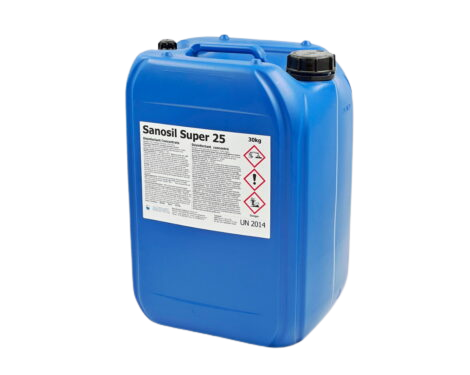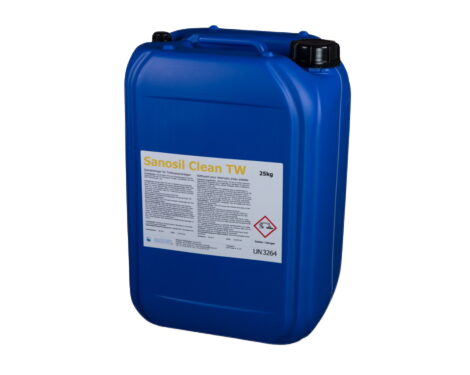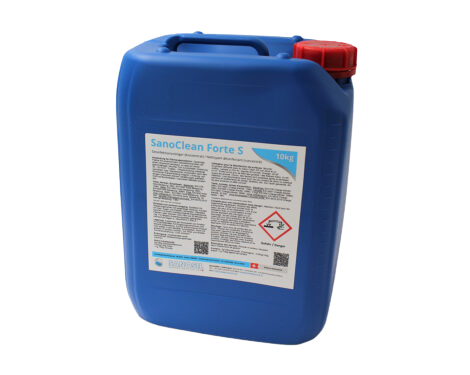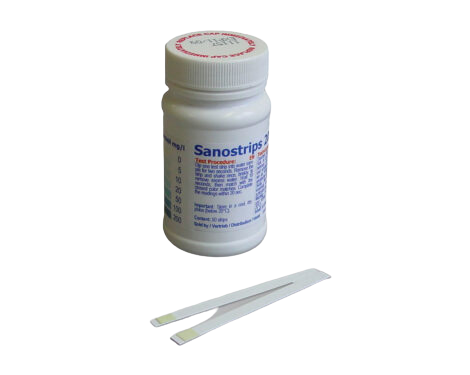[breadcrumb]
DRINKING WATER TREATMENT
Conditioning and Storage of Drinking Water
Drinking water treatment chemicals in public and private areas.
Possible limitation of the use of Sanosil products for drinking water treatment in some countries.
Drinking water treatment with products containing hydrogen peroxide such as Sanosil requires appropriate approvals, which are not available for all countries.
Without approval for drinking water treatment, Sanosil products may only be used for process water treatment.
Please check the legal use of the products with the competent authority.
Drinking water treatment chemicals at the waterworks
Drinking water has been industrially processed with drinking water treatment chemicals in large plants for around 150 years. This resulted from the recognition of a link between polluted drinking water and diseases such as typhus and cholera, and thus the need for effective drinking water treatment to prevent them.
Depending on the source of the untreated water, different processes are used to produce drinking water, since the quality and chemical composition can vary. For example, there are different types of untreated water: meteoric water (rain), surface water (lakes, rivers), spring water and groundwater.
Today, drinking water treatment includes technologies tailored to the properties of the untreated water, such as cleaning, sterilisation, removal of iron and manganese and, depending on the desired degree of hardness, desalination/softening, as well as the addition of minerals to protect the water pipes against corrosion. If necessary, drinking water disinfectant is also added to prevent re-contamination in a process known as „line protection“.
Wastewater treatment is also related to this topic, however this will not be examined in more detail here.
[expander_maker id=”2″ more=”Read more” less=”Read less”]Treatment of drinking water: mechanical processes
The mechanical processes used to purify drinking water are among the oldest and simplest methods of drinking water treatment. For example, gravel filters and sand filters were used as early as the Middle Ages to clean rainwater before storing it in a cistern. Other mechanical methods used in drinking water treatment include rakes, sieves and filters, including both nano and osmosis filters. In addition to sand and kieselguhr, activated carbon filters are also commonly used in waterworks.
During drinking water purification, the aim is to remove turbid substances such as sand, algae, dirt, etc. from the untreated water. Flocculants are also often added to increase the efficiency of the filters. These substances ensure that small particles of dirt coalesce to form larger clumps, which then get caught in the filter meshes. The filters themselves must be backwashed regularly in order to prevent caking. When the filters are backwashed, the suspended solids are flushed out and washed away in the opposite direction.
Drinking water treatment chemicals & chemical processes
It is not possible to remove all undesirable substances from drinking water with conventional filters alone. Eliminating dissolved substances in particular requires other means. Many of these, such as iron and manganese, can be removed with oxidation. For this purpose, either oxygen, air, hydrogen peroxide or potassium permanganate based drinking water treatment chemicals are added to the water. The latter is also available in tablet form for drinking water disinfection (chlorine tablets) or for drinking water treatment during outdoor activities.
By blowing air into the water, substances can also be converted into a gaseous form and thereby „blown out“ or removed, e.g. excess chlorine, hydrocarbons, sulphur compounds, etc. This process improves the water’s taste by removing unwanted odours and is known as stripping.
A hybrid form of both chemical and mechanical water treatment involves the use of absorbers. Water filters containing activated carbon have proved their worth in this field. The huge surface area of the activated carbon and the readiness with which many substances bind to it allow other undesirable substances to be extracted from the water.
Drinking water treatment-biocidal processes / disinfection
In addition to filtration, biocidal technologies are also used to disinfect drinking water. Well-known methods of biocidal water treatment include UV disinfection (UV rays kill germs very quickly), ozonisation, chlorine dioxide chlorination and special drinking water disinfectants such as Sanosil Super 25. The focus here is on killing all microbes sustainably and reliably without negatively affecting the taste of the water.
Thermal disinfection (boiling of water) is not viable in large-scale drinking water treatment plants due to the required high energy consumption, and is really only practical for outdoor pursuits and/or as an emergency measure in the household (e.g. in case of sudden microbial contamination).
In order to subsequently preserve the treated drinking water and protect it against recontamination, a process known as line protection is carried out. The effects of ozone and UV are acute, but they do not last. Therefore, a small amount of drinking water treatment chemicals in the form of a disinfectant in drinking water treatment is added to the drinking water. While this makes perfect sense from a technological point of view, it is also the subject of some criticism. Essentially, many consumers dislike the idea of a drinking water disinfectant being added to their drinking water. In addition, when using an established disinfectant for drinking water, the risk of corrosion must always be taken into account — particularly because chlorine dioxide, which is becoming increasingly popular, is highly corrosive.
Domestic service-water treatment
As mentioned above, drinking water treatment is usually managed at the municipal level. However, some consumers operate private water treatment systems for a variety of reasons. Generally speaking, this occurs on land with its own spring, spring tapping or groundwater well. The effort and expense involved depends largely on the desired quality of the untreated/drinking water.
If the water is only used only for gardening, showering, washing and toilet flushing, and the water in the collecting tank is replaced regularly, simple filtration via two successive, backwashing filter cartridges — combined with periodic cleaning of the water catchment — is generally sufficient.
Domestic drinking water treatment
On the other hand, in order to produce drinking water using your own system, additional effort is required. The easiest way to do this is with a multistage system for domestic drinking water treatment. These devices usually take the form of various modules connected in series, which combine pre-filters, ceramic filters, activated charcoal filters and UV sterilisation or pre-filters/osmosis filters. Provided they are used and maintained properly, these devices are also able to produce safe domestic drinking water from privately owned sources.
Contrary to popular belief, water disinfectants / chemical drinking water disinfection with chemicals used in drinking water treatment, is not usually necessary for domestic water treatment. In contrast, regular maintenance, inspection and, if necessary, cleaning and disinfection of the spring tapping / collection well, pumps and possibly pipelines with drinking water treatment chemicals produced by renown drinking water treatment chemicals suppliers is strongly recommended.
The Sanosil products (S015 / Super 25) can also be used directly for drinking water disinfection and emergency water conservation. They are most widely used in highly technical water treatment applications (cooling towers, cooling circuits), for combating the spread of legionellae, as well as for disinfecting wells, pipes and water treatment plants.
[/expander_maker]
CISTERNS & RESERVOIRS
Cleaning & Desinfection of Drinking Water Chambers
Drinking water tank cleaning and disinfection
Why drinking water tank cleaning and disinfection of water storage tanks? Drinking water chambers / tanks are used to store our most important foodstuff — potable water. Our health depends on ensuring it is of high quality, which in turn depends on regular maintenance, cleaning and disinfection of cistern tank i.e. of all its components within a functional drinking water supply. Here are some hints and tips for the optimal treatment of drinking water chambers, spring tappings and drinking water tanks.
CLEAN TW :
DRINKING WATER STORAGE TANKS CLEANER
SUPER 25 FOR THE DISINFECTION OF WATER TANKS IN TRAINS/SHIPS
S015 FOR THE DISINFECTION OF WATER TANKS IN TRAINS/SHIPS
COMPARISON
DRINKING WATER STORAGE TANKS CLEANER
Water tank cleaning: the basics
Water tank cleaning is important and complicated because pollution and biological contamination in drinking water tanks can have many causes. However, these can generally be divided into three categories:
– Dirt ingress into the drinking water chambers due to construction/conversion work (e.g. sludge/fecal matter), floods and/or animals such as mice or similar (direct pollution/primary contamination)
– Contamination of drinking water tanks or spring tappings resulting from use of unsuitable materials (e.g. pipes containing plasticisers that promote microbial growth), thread grease, lubricants or foreign materials such as rags, sawdust, etc. (indirect pollution/secondary contamination)
– Contamination due to chemical/physical/biological factors (e.g. limescale deposits), which are conducive to biofilm growth. (Exponential source of contamination)
All of these factors share one thing in common — they can act as sources of repeated contamination. In other words, there may be sites within the drinking water system that continuously contaminate the water with microbes. This is virtually unavoidable in points two and three above. In addition, the problem is exacerbated in all three cases by the fact that even disinfection of potable water storage tanks with high doses of disinfectant usually only serves as a temporary remedy.
[expander_maker id=”2″ more=”Read more” less=”Read less”]Cleaning and disinfection of drinking water tanks in the event of direct contamination.
Direct pollution is often the result of flooding, whereby mud, soil and microbes overflow into the drinking water chambers or spring tapping. Alternatively, improper spreading of manure in the water protection zone can result in contamination. This is characterised by cloudy water, changes to its taste and sudden, high concentrations of microbes — in particular, a high number of fecal germs.
In such cases, although the contents of the drinking water tank are typically polluted and contaminated with microbes, the walls and pipes remain free from sediment/mucosal layers. For this reason, it is usually sufficient to drain the entire water supply system and spray the walls and possibly the pipes thoroughly with water (fire hose). Subsequent surface disinfection will remove any adhering microbes. The drinking water chamber can then be refilled, possibly with the addition of some disinfectant i.e. drinking water tank cleaning chemicals as a precaution. After the water tank cleaning, once the disinfectant has degraded, the water supply is ready to be reconnected to the network.
Drinking water tank cleaning and disinfecting in the event of indirect pollution / secondary contamination
The materials used in water supply systems are specifically certified to ensure their suitability for this purpose. Non-certified materials, such as all kinds of garden hoses, plastic parts, plastic films, etc. are sometimes also used in drinking water supply systems out of ignorance (especially in privately created spring tappings), which may have unpleasant consequences.
Many plastic parts contain plasticisers and other substances that promote microbial and biofilm growth in drinking water supply components. Cleaning and disinfecting these incorrectly designed drinking water chambers can provide a short-term fix for the problem, however the maintenance cycles necessary for these tanks are significantly shorter compared to other drinking water systems. The only effective remedy in such cases is to replace the problematic materials or possibly add inlays.
However, in the event of contamination with fats or oils, these substances can often settle and solidify on a surface or inside a pipe connected to the drinking water tank. Microbes can then multiply under this water-repellent layer, resulting in continuously high levels of bacterial growth (usually aerobic, mesophilic bacteria) in the drinking water chambers. If this occurs, the system must be cleaned using a highly alkaline drinking water reservoir cleaning solution (e.g. sodium hydroxide). The tank must first be neutralised with acid and then flushed with water before all surfaces are disinfected (see pt. 1). Smaller contaminants can also be specifically treated with an suitable disinfectant cleaner, such as SanoClean.
Water tank cleaning and disinfection in the event of exponential contamination.
The chemical composition of the water determines both the speed with which deposits are formed and their severity. These deposits usually consist of lime, manganese and possibly dissolved iron. While the deposits themselves are safe from a hygienic point of view, by creating rough surfaces on the walls of drinking water containers they act as an ideal „primer“ for biofilms containing algae, mould and bacteria.
These deposits must therefore be regularly removed from the walls of the drinking water chambers. Drinking water tank cleaning chemicals, more precisely a strongly acidic special cleaner for water tank cleaning such as Sanosil TW, which can break down and detach the limestone layers, is ideal for this purpose. Rusty iron oxide deposits can be additionally treated and removed by means of antioxidants. Naturally, the acid must then be neutralised with an acid/base solution and flushed out. The surfaces and contents of the drinking water system are subsequently disinfected.
Drinking water storage tank disinfection: Tanks with smaller volumes
It may be possible to treat smaller tanks directly by means of shock drinking water tank disinfection. However, this only works if the source of contamination is „visible“ in the drinking water chamber and not concealed by a solid layer of dirt — otherwise, this layer would shield the microbes from the disinfectants.
Procedure: a relatively high dose of water tank cleaning products (such as 500–1000 ppm Sanosil Super 25) is added to the contents of the drinking water chamber, spring tapping or tank, and mixed by means of a pump. Treatment time takes between four to twelve hours. The disinfectant solution is then drained and discarded. It is essential to ensure that this water is not accidentally used for drinking! After a brief rinse and, if necessary, a refill, the disinfection of water storage tanks is complete.
[/expander_maker]
DRINKING WATER PIPES
Disinfection, corrosion protection and hardness control
Potable water pipe disinfection, cleaning and corrosion protection
Drinking water pipe disinfection in drinking water pipes and drinking water installations is certainly not a new invention. After all, the Romans succeeded in creating a functional and effective water supply based on aqueducts and drinking water pipes made from lead and wood. They also recognised that drinking water pipes require regular maintenance and servicing in order to function effectively — and this principle still applies today.
WATER LINE DISINFECTION WITH SANOSIL SUPER 25
WATER LINE DISINFECTION WITH SANOSIL S015
Potable water pipe disinfection and building installations: responsibilities
Potable water pipe disinfection is the responsibility of different authorities. While the waterworks and municipal authorities are responsible for ensuring high water quality right up to the transfer point to the building’s mains connection, from this point on the operator of the building installation is responsible for maintaining the water quality in the drinking water pipes through proper potable water line cleaning.
Basically, the municipal authorities take care of everything in front of the water meter (and are therefore responsible for sanitizing potable water lines), while the building’s owner is responsible for everything behind it (and as far as every tap).
Besides the drinking water pipes, relevant building installations may include water meters, filters, dosing systems, softeners and heating systems (boilers and hot water pipes). And the potential problems that need to be avoided and corrected are just as diverse as the installations themselves.
For example: corrosion in drinking water pipes, microbial growth and biofilm formation in filters, and/or pipes containing stagnant water, legionella growth in hot water installations, etc.
[expander_maker id=”2″ more=”Read more” less=”Read less”]Corrosion in drinking water pipes & corrosion inhibitor for water
Depending on its chemical composition (hardness, CO2 content, mineralisation, etc.), water is either corrosive or depository. The softer and hotter the water, the sooner it will begin to corrode metal water pipes. The same is true for galvanised water pipes. Drinking water pipes made from cast iron, copper or even lead (now banned) are also not immune to corrosion. The problem is that fragments of metal may become detached from the pipes and pollute the water. Although „red water“ contaminated with iron/rust is not poisonous, other metals can represent a health risk.
Drinking water pipes that are seriously damaged by corrosion must always be replaced. Larger pipes can be repaired using plastic inlays.
Alternatively, drinking water pipes can be cleaned using a corrosion inhibitor for water, for example phosphate, phosphonate or polyphosphate solutions. These mineral solutions (such as Corfit Pipe Shield) form a thin protective layer inside corroded drinking water pipes and prevent further corrosion.
Silicate products can also be added to the water to ensure permanent treatment of the pipes. (Corfit Pipe Care A / Corfit Pipe Care B / Corfit Pipe Care Si)
Potable water pipe disinfection : stagnant water
Drinking water is rarely sterile but it requires potable water pipe disinfection in a certain point. In order to be classified as drinking water it may not contain more than a specified number of microbes. If the water remains in a section of the pipeline for a long time (so-called stagnation zones or dead strands), bacteria and algae can multiply. It is even possible for these stagnation zones to cause backward contamination in the regular drinking water pipes.
As a quick remedy and form of prevention, it is advisable to regularly flush critical pipe sections — especially if a drinking water pipe has not been used for two weeks or longer. It is important to ensure that water-carrying extinguishing pipes are also flushed. For prolonged periods of non-use, these pipes can be drained.
On the other hand, if significant microbial contamination with biofilm formation has already taken hold due to negligence, the potable water pipe disinfection of drinking water pipes must be performed with Sanosil S015 or Super 25 water pipe cleaning chemical (disinfectants), which contain hydrogen peroxide (shock disinfection of the drinking water pipe with subsequent flushing).
Combatting legionellae: disinfecting potable water piping and hot water installations
Legionellae are a serious problem in hot water systems — they multiply explosively at temperatures between 30 and 40 degrees Celsius. If water droplets containing legionellae are then inhaled when showering, they can cause severe, sometimes fatal pneumonia.
Although the problem can be eliminated in many cases by means of a legionella protection circuit (in which the water in the boiler is sporadically heated to +60 degrees Celsius), this is not always possible for technical or design-related reasons. In such cases, only the sporadic or continuous treatment of the water pipes and hot water installations with a drinking water line disinfection product is effective (same procedure as with stagnant water: shock disinfection of potable water lines and all pipes, leave to take effect, then flush).
Disinfecting water softeners, filters, water meters and other water installations
In addition to drinking water pipes, a large number of other installations also require regular cleaning and maintenance. For example, filters must be changed, softeners rinsed and salt tanks cleaned on a regular basis. However, frequent disinfection of these system components with a water pipe cleaning chemical may or may not be necessary.
Flushing with drinking water pipework disinfection solution (or filling and leaving for a while) is one option; alternatively, after potable water pipe cleaning, all disassembled and cleaned parts can be directly sprayed with undiluted disinfectant for potable water pipe disinfection (Sanosil S003).
[/expander_maker]
COOLING WATER
Cooling water treatment with Sanosil products
Cooling water treatment is very important: the moment a cooling water circuit (particularly an evaporative cooler) is put into operation, several issues quickly arise which, unless taken care of, will result in the cooling water not only performing heat exchange but also degrading the system’s efficiency. Using cooling tower water treatment chemicals such as corrosion inhibitors, hardness stabilisers and biocides for cooling tower water treatment is an art unto itself.
DISINFECTION
Control of biofilms, Legionella and microbiological corrosion
Cooling water treatment with Sanosil products
Cooling water treatment is very important: the moment a cooling water circuit (particularly an evaporative cooler) is put into operation, several issues quickly arise which, unless taken care of, will result in the cooling water not only performing heat exchange but also degrading the system’s efficiency. Using cooling tower water treatment chemicals such as corrosion inhibitors, hardness stabilisers and biocides for cooling tower water treatment is an art unto itself.
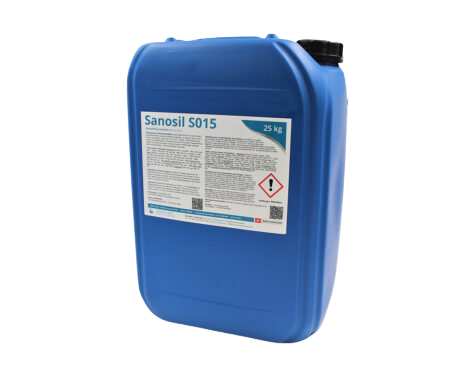
Sanosil S015
Disinfectant concentrate
for water disinfection,
no dangerous good
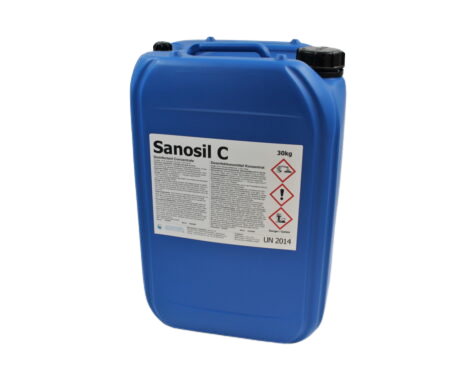
SANOSIL SUPER 25
Highly concentrated biocide
for cooling water
water treatment
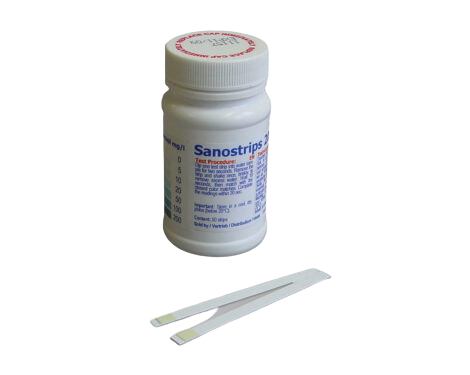
Sanostrips 200
for the approximate determination of the
Sanosil content in water.
Why is cooling water treatment with chemicals necessary?
Here is a brief introduction to cooling water treatment:
Nearly all industrial manufacturing processes, energy generation, building services and data centres generate large quantities of heat, which needs to be removed to prevent the systems from overheating. Wet cooling towers are a preferred method for releasing surplus heat into the environment. The pumps, heat exchangers, pipes as well as the cooling water which circulates between the heat source and the cooling tower are collectively referred to as the cooling circuit.
[expander_maker id=”2″ more=”Read more” less=”Read less”]As cooling water tends to cause sediment or corrosion, depending on its chemical makeup, and pathogens such as bacteria, fungi and algae multiply explosively in untreated warm water, it is mandatory counteract these effects by treating the cooling water with suitable chemicals. Cooling water without chemicals quickly leads to problems, and can even become hazardous for the environment (legionella). Let’s take a look at the most prevalent cooling systems:
Cooling tower water treatment systems 1: open evaporative cooler
In this system, the heated cooling water is sprayed onto a system of fins in the cooling tower, which provide a greater surface area. A push or pull fan, or the stack effect, generates a powerful draft. As the water evaporates, heat is removed from it, reducing the water temperature. The cooling water can be fed directly into the cooling process.
Open evaporative cooling towers can vary in design and be round, square or even V-shaped.
Because the cooling water in open systems has intensive contact with dust and dirt, pathogens and biofilms can quickly form unless it is treated with biocides. Also, evaporation increases the concentration of salt and chalk in the water (thickening). Therefore, when it comes to water treatment for cooling towers of this kind, in addition to hardness stabilisers and corrosion inhibitors, it is also necessary to add dispersants to prevent dirt and limescale.
Cooling water treatment for system 2: closed-circuit dry cooling
The cooling water (water, corrosion inhibitor and antifreeze) flows through the pipes of a heat exchanger. Fans push the air through the cooling fins, transferring heat energy to the ambient air. The cooling water does not evaporate. This makes it a conventional closed-circuit system.
The system is widespread (cars make use of a small version, for example). After the initial conditioning when filling (which, however, does require a particularly high-quality cooling water treatment with cooling water treatment chemicals such as molybdates to inhibit corrosion), the softened/desalinated water needs little maintenance.
Admittedly, the inferior efficiency of air cooling means the power usage for the fans tends to be higher than for wet cooling with higher temperatures.
Semi-open evaporative coolers / hybrid systems
In these cooling tower water treatment systems, a closed system (similar to a dry cooler) is run across a heat exchanger and does not come into direct contact with the ambient air. The heat exchanger’s tube bundles are usually smooth for easier maintenance and are sprayed with water in a second, open cooling circuit, which results in the cooling water in the closed part of the circuit cooling more rapidly. The cooling water only evaporates in the open section.
When temperatures are very low (winter) and if the cooling load is low, it may even be possible to dispense with water cooling (dry operation) and maintain cooling with the draft from the fans alone. In this case the cooling water is either drained or stored in a frost-proof storage tank.
Cooling systems of this type require separate chemical cooling water treatment for the open and closed sections. The open section periodically requires hardness stabilisers, corrosion inhibitors and biocides, whereas the closed section only needs a high dose of corrosion inhibitor and a little biocide when filled.
Problems when operating a cooling circuit and how to solve them
Corrosion:
Cooling water either scales or corrodes. The softer the cooling water in the circuit, i.e. the fewer dissolved solids it contains, the more aggressively it will dissolve materials such as iron and other metals. It will cause pitting, leaks and other problems resulting from corrosion.
Corrosion inhibitors or anti-corrosives (e.g. phosphates for open and molybdates for closed cooling circuits) protect the cooling system’s surfaces.
Scaling:
Hard cooling water is rich in dissolved solids such as salts and calcium. When the cooling water heats up during operation, CO2 escapes, which keeps the calcium in suspension. The calcium precipitates and begins to form limescale. This protects against corrosion, but also prevents the transfer of heat in the heat exchanger. As a result, it substantially reduces the effectiveness of the cooling circuit.
Hardness stabilisers such as phosphates prevent the calcium from crystallising, and therefore from forming crusts. Instead, it can be flushed out via the desalination system.
Biofilms:
Warm water is a perfect breeding ground for all kinds of microorganisms. They rapidly form slimy deposits which can become quite dense in a very short time. Like calcium deposits, they prevent heat transfer in the heat exchanger and reduce its efficiency. What’s more, these germs can be a health hazard that should not be underestimated, if for instance cooling water aerosols containing legionellae are spread near the cooling towers and inhaled.
Treating the cooling water with biocides like Sanosil C eliminates these biofilms and sources of pathogenic bacteria and prevents them from growing.
An automated dosing of cooling water treatment chemicals monitors and regulates the content of all necessary chemicals, and is imperative for unproblematic cooling water treatment.
[/expander_maker]
WATER LINE DISINFECTION WITH SANOSIL SUPER 25
Drinking water disinfection – Handy tear up bag
Legionella Treatment in buildings – step by step – A4 printable format – V1.0
New Zealand Approvals and Registrations IDS6.9b Approvals
Quantity required for Drinking Water Treatment
Sanosil Disinfectants – Effect on Biofilms V1.0-1
Sanosil Super 25 Use for Drinking Water Disinfectant V2.1.
Super 25 Use for drinking water installations
WATER LINE DISINFECTION WITH SANOSIL SUPER 25
WATER LINE DISINFECTION WITH SANOSIL S015

